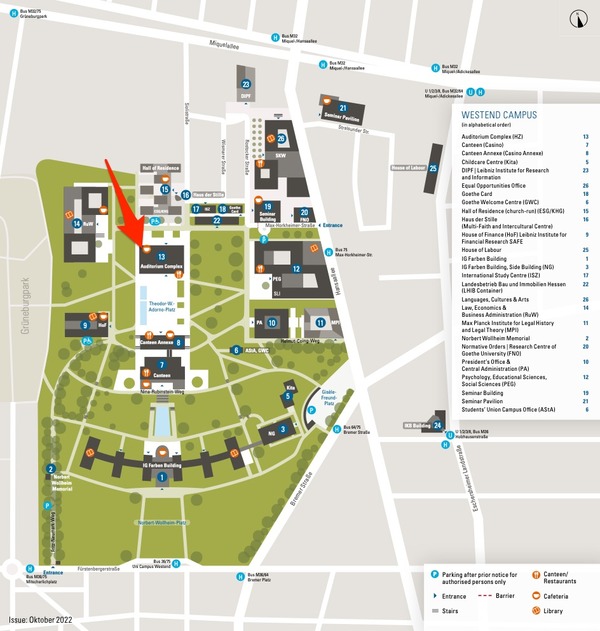Conference Location
Goethe-Universität Frankfurt (Campus Westend)
Theodor-W.-Adorno-Platz 1
60323 Frankfurt am Main
Campus
Campus Westend is one of five campuses and the most modern of Goethe University Frankfurt. Built in 2008, with its park-like setting, several cafes, and the historical IG Farben Building it is often described as one of the most attractive campuses in Germany. The campus is situated in walking distance of the center with its historical attractions.
Throughout its history, the location of today's Campus Westend has been used for different purposes. During the 18th and 19th century, the area of Campus Westend and the adjacent Grüneburgpark was home to the estates of Frankfurt's patrician families, such as the von Rothschild and Goethe families. In 1859, Frankfurt’s first modern psychiatric hospital was build on the site, going back to the the author of Struwwelpeter, Heinrich Hoffmann, who laid the foundation for modern neurology. In 1931, the IG Farben building was completed. It served as the headquarters of IG Farben, the world's largest chemical company. IG Farben became an early supporter of the NSDAP and later developed and produced the gas used for the genocides committed by Nazi Germany. Following the end of WW2, the former IG Farben headquarters were taken over by the American military administration, who stayed there until the reunification of Germany. Today, the building is part of Goethe University's facilities and hosts, among others, the faculties of history and philosophy.
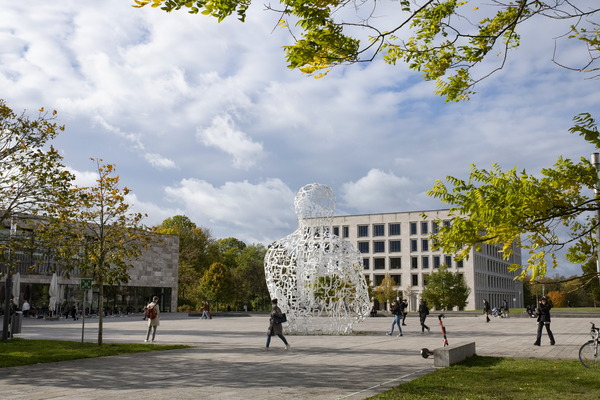
Source: Peter Kiefer, Goethe University
All of the conference sessions will take place in the Auditorium Complex (abbreviated HZ and No. 13 on the map below), right at the center of the campus. Luncheons, receptions, and the conference dinner will also be on campus. For the best coffee, take a quick walk to Hoppenworth & Ploch, which is located at the ground floor of building No. 15 (see map below).
Frankfurt
Frankfurt is one of the most important financial centers in Europe, but it has much more to offer than just banks and its skyline. We selected some places that are worth a visit.
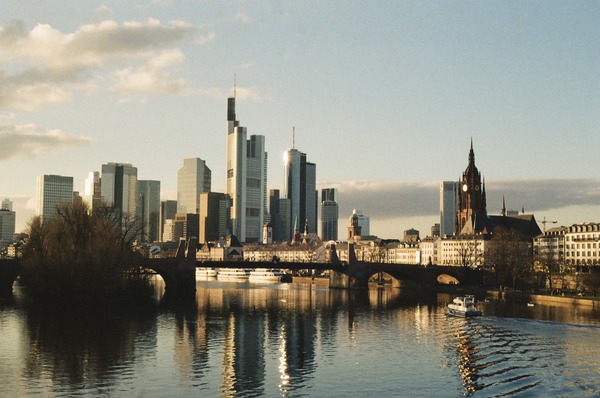
Source: Charlotte Hoppe
Römer (City Hall) and Römerberg
The Römer building has been serving as the city’s town hall since 1405 and continues to be the seat of the mayor till this day. At the time of the German Empire, the emperor’s hall, part of the town hall complex, also served as the location for the great coronation banquet. Right across the gabled house you will find a row of restored half-timbered houses that make a great photo subject.
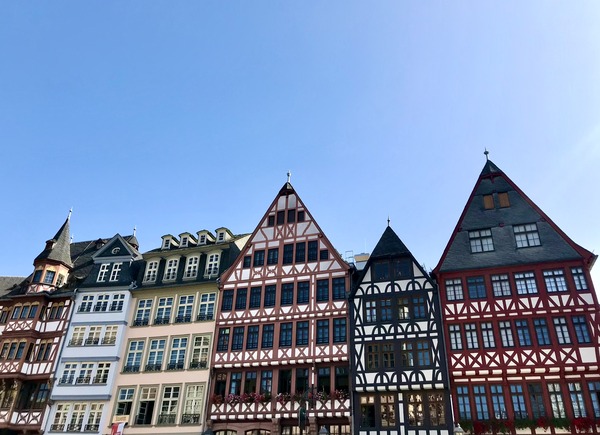
Source: Charlotte Hoppe
Reconstructed Old Town
Right behind the Römer square the reconstructed old town starts. Since the majority of Frankfurt was destroyed during World War II, it also lost its historical center in the aftermath. In 2014, the city decided to reconstruct some of the old houses to bring back part of the original character of the old city center to the heart of Frankfurt.
Kleinmarkthalle
Located close to the historic center is the indoor market Kleinmarkthalle. Next to a seemingly never-ending variety of fresh produce, cheeses and pastries, the Kleinmarkthalle also offers a great opportunity to get a taste of some Frankfurter specialties, such as Grüne Soße (green sauce made from a specific mix of seven herbs) or a glass of Apfelwein (a type of apple cider).
Sachsenhausen
On the other side of the Main river, you will find the Sachsenhausen district, which is home to the Brückenviertel (bridge quarter). Here, you can take a browse through the several small vintage clothing and music shops or enjoy a typical Frankfurt evening at one of the several Apfelwein bars.
Städel Museum
Located between the Brückenviertel and the Main River, the museum embankment is home to several of the city’s most loved museums, including the Städel Museum, which is one of Europe’s leading art museums. Its collection includes over 3,000 paintings from the Middle Ages to modern and contemporary art and the historic building itself is already worth a visit.
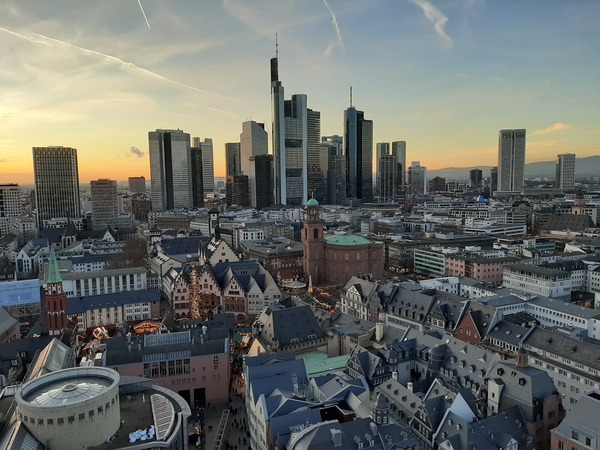
Source: Sebastian Koch
Additional ideas for your sightseeing tour:
- Main Tower or the Cathedral (Dom): spectacular panoramic view of Frankfurt
- Kaiserpfalz franconofurd: archeological excavation site next to the cathedral, showing traces of Roman legionnaires and Franconian kings
- Goethe House: originally furnished rooms in the house where Goethe was born and spent most of his youth
- Old Opera House (Alte Oper): beautiful historical façade
- Palmengarten Botanical Gardens: home to a wide variety of flowers, plants and the butterfly house
Additional ideas for activities outside of town:
- Mountain range Taunus located in the north west of Frankfurt. You may go for a hike or visit the Saalburg — a restored Roman fortress of the Limes fortification, which is a UNESCO World Heritage Site.
- Wine region Rheingau with its beautiful villages, great Riesling, and the famous monastery Kloster Eberbach (the location of the movie “The Name of the Rose” and part of the UNESCO World Heritage Site Upper Middle Rhine Valley)
For additional information, city tours, and plans, visit https://www.frankfurt-tourismus.de/travel-industry/This-is-Frankfurt
Getting from the Airport
Frankfurt Airport is very close to the city center. The easiest way of commuting between the airport and the city is by regional train. The airport’s regional train station (German: Regionalbahnhof) is located in the ground floor of the airport, below terminal 1. Just follow the signs towards Airport City Mall/Regionalbahnhof.
There are several lines connecting the airport with the city center. During daytime, you will therefore never have to wait more than 15 minutes for the next train to arrive. Travelling time until Frankfurt Central station is only around 13 minutes. You can use the S-Bahn trains S8 and S9 or the Regional Express (RE) with the numbers RE2 and RE3. Under normal conditions, all these trains leave from platform 1. While the S-Bahn trains are going in the direction of Hanau Hauptbahnhof, the final destination of the Regional Express is Frankfurt Hauptbahnhof.
A single ticket from the airport to your final destination within Frankfurt costs 5.80 Euros. In case you want to use public transport within Frankfurt at least two more times on the same day, it is however advisable to buy a day ticket. A day ticket that covers both the ride from the airport to your first destination as well as an unlimited use of public transport within the city costs 11.30 Euros. See the section on public transport below.
You can buy a single or day ticket using the vending machines that you find in the airport’s regional train station before going down the escalator to platform 1. All vending machines accept cash as well as bank and credit cards, including VisaCard, MasterCard, and American Express. Alternatively, you buy your ticket using the mobile app RMVgo.
Public Transport
Public transport is provided by the RMV (Rheim-Main-Verkehrsverbund). Getting around within the city is very easy using the dense network of the suburban rail service (S-Bahn) and the subway (U-Bahn). There are also bus and tram lines. However, most destinations, including hotels and the university campus, are usually within a walking distance from an S-Bahn or U-Bahn station.
The closes train station to the conference venue is the subway station Holzhausenstraße. It is served by the subway lines U1, U2, U3, and U8. Walking from the subway station Holzhausenstraße to the conference venue takes about 9 minutes. Click here to open a plan of train connections within Frankfurt and its surroundings.
What is the cheapest ticket for using public transport depends on (i) whether you want to commute between the airport and the city, which are located in different tariff zones, and (ii) how many rides you are going to make in the city.
- On a day on which you need transfer from or to the airport:
- If you are planning to make only one more ride within the city: Buy a single ticket at the airport to go from the airport to your final destination within the city (5.80 Euros). Later, you buy another single ticket for a ride within Frankfurt (3.40 Euros).
- If you are planning to make at least two more rides within the city: Buy a day ticket from the airport to the city (11.30 Euros). It also covers an unlimited number of rides within the city.
- On a day on which you do not need transfer from or to the airport:
- Buy a single ticket for a single ride (3.40 Euros) and a day ticket (6.65 Euros) when making at least two rides within the city.
With any ticket you buy, you can use all modes of public transport, that is, S-Bahn, U-Bahn, Regional Express trains, buses, and trams. In case you are buying a day ticket and you are travelling with at least one more person, you should consider buying a group day ticket. It covers up to five people and costs 19.10 Euros when including the airport and 12.60 Euros when excluding the airport.
Day Trip to Seligenstadt
For all those who are interested in some sightseeing, we have a special offer: On August 27, Gudio Friebel’s PhD student Sebastian is offering a little day trip to his home town Seligenstadt. Seligenstadt is a small town of around 22,000 inhabitants, located 25 km in the South East of Frankfurt. It is known for its picturesque old town with half-timbered houses from the 17th and 18th century. Its most important landmark is an old monastery, which was founded in the year 830 and encompasses a basilica and a beautiful garden. Although a very famous destination among local tourists, Seligenstadt is still largely undiscovered by international travelers. Your chance to get to know a hidden gem! We will start our day trip in the morning, explore the town, have lunch in a local restaurant, and arrive back to Frankfurt in the late afternoon. If you are interested or you have any questions, please get in touch with Sebastian (s.koch@its.uni-frankfurt.de).
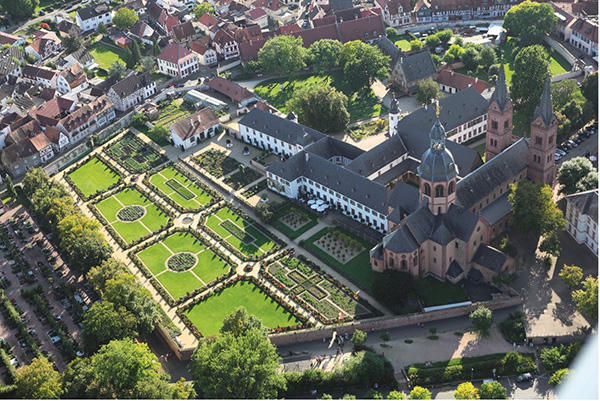
Source: Mathias Neubauer
Further Questions?
In case you have any questions with respect to your stay in Frankfurt, please do not hesitate to contact Charlotte Hoppe (c.hoppe@em.uni-frankfurt.de) or Sebastian Koch (s.koch@its.uni-frankfurt.de).

